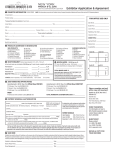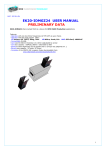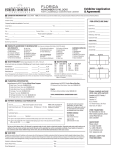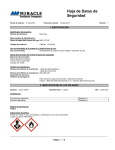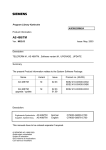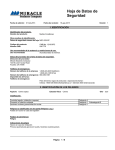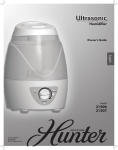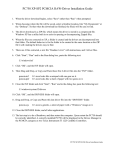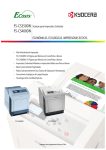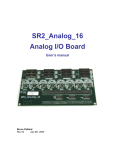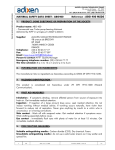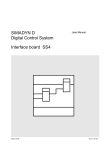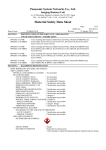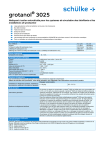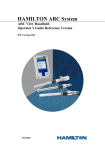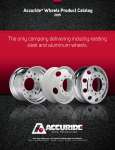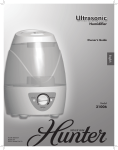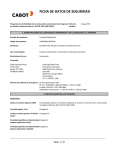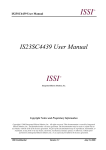Download Safety Data Sheet (SDS) - Thai Plastic and Chemicals
Transcript
TPC PASTE RESIN COMPANY LIMITED 1 Siam Cement Rd. Bangsue, Bangkok 10800, Thailand Revision: 5 Effective date: Jan 13, 2015 More information and/or complaint please contact : Tel : +66 2827 7211 or +66 3892 5200 Fax : +66 2586 5488 Safety Data Sheet (SDS) 1.Identification Product Name : PG620(62GP), PG680(68GP), PG740(74GP), PG770(77GP), PS670(67SF), PC750(75HC), PS671, PS680, SW301WW, PM990OB Chemical Name : Ethene, Chloro-Homopolymer Synonyms : Polyvinyl chloride Product Use : Industrial raw material for plastics processing Manufacturer : TPC Paste Resin Co.,Ltd. Address : 1 Siam Cement Rd. Bangsue, Bangkok 10800, Thailand General Information : Tel: +66-3892-5200 Fax: +66-2586-5488 Emergency Telephone Number: +66-3892-5200 2.Composition/information on ingredients Component Ethene, chloro-, homopolymer (PolyVinyl Chloride) CAS number % by Weight 9002-86-2 100 3. Hazards Identification HMIS® rating (product as packaged) Health: 0 Fire: 1 Reactivity: 0 POTENTIAL HEALTH EFFECTS: Inhalation: Inhalation of dust may cause irritating to the respiratory tract and breathless. Prolonged inhalation exceeding TLV can lead to damaging effect as a result of mechanical overloading of the respiratory tract. Skin contact: Dust may cause irritating to the skin. Eyes contact: Dust may cause irritating to the eyes. Ingestion: Not a likely route of exposure. This material is not hazardous under OSHA criteria. This material is not hazardous under WHMIS criteria. 4.First aid measures Inhalation: Remove to fresh air immediately. If cause irritant or unwell breathe should be use a bag valve mask or similar device to perform artificial respiration (rescue breathing). Get medical attention immediately. Skin contact: Immediately flush skin with mild soap and large amounts of water. Eye contact: Wash eyes immediately with large amount of water or normal saline solution, occasionally lifting eyelids. Get medical attention if irritation remains. Ingestion: No effect expected. If large amounts are ingested, get medical attention immediately. 5.Fire Fighting measures Extinguishing Media: Dry chemical, carbon dioxide, water, foam 1 Fire Fighting: Keep unauthorized personnel away, isolate hazard area and deny entry, firefighting with upwind. Wear self-contained breathing apparatus (SCBA) and full protective clothing. Flash point: 736 deg. F or 391 deg. C (Method: ASTM D1929) Auto-ignition temperature: 849 deg. F or 454 deg. C Explosion Limit Upper Explosion Limit: not available Lower Explosion Limit: not available Hazardous Combustion Products: Hydrogen chloride, Oxides of carbon 6.Accidental Release measures Personal precautions: Evacuate unnecessary personnel and eliminate all sources of ignition. Personal protection equipment: Wear personal protection equipment follow by section 8 (Exposure controls / personal protection) Environmental precautions: Contain spills with dike to prevent entry into sewers or waterways. Method and equipment for cleaning up: Sweep or vacuum cleaning Polyvinyl chloride that spills with minimum dust. Collect spills material in appropriate container and identify for disposal. 7.Handling and storage Handling Procedure: Use only in adequate ventilation area. Using this material should be use method to minimize generation of dust emissions. Preventing accumulation of dust and eliminating potential ignition sources. Avoid breathing, contact to skin and eyes by wear personal protection equipment. Wash thorough after handling. At temperature more than 100 deg.C may cause thermal degradation of PVC in the formation of hydrogen chloride and oxides of carbon, So that using more than 100 deg.C should be use heat stabilizer. Sensitivity to static electricity: Electrostatic charges may build up during processing equipment. Grounding is recommended. Storage Condition: Store in a cool, dry area. Keep away from heat, sparks, flames and other ignition sources. Store in adequate ventilation area. Product arrangement, please study in PVC paste resin user manual. 8.Exposure controls / personal protection Occupational Exposure Limits: United States CAS ACGIH:TLV Component OSHA Final PEL China OELs number (8 hour TWA) 8 hour TWA 3 10 mg/m3 15 mg/m Ethene, chloro 3 (total dust) 5 mg/m (TWA) (nuisance Dust) 9002-86-2 3 ,homopolymer 5 mg/m 10 mg/m3 (STEL) 1 mg/m3 (PolyVinyl Chloride) (respirable dust) (respirable dust) OEL: Occupational Exposure Level; TLV: Threshold Limit Values; TWA: Time Weighted Average; STEL: Short Term Exposure Level; PEL: Permissible Exposure Level; OSHA: United States Occupational Safety and Health Administration; Engineering controls: General room ventilation plus local exhaust at points of emission to maintain levels of airborne contaminants below occupational exposure limits. Personal protection equipment: Respiratory protection: Wear respirator with high efficiency dust, mist and fume filters. Eye protection: Wear safety glasses or goggles to protect eyes. Skin and body protection: Wear suitable protective clothing to minimize skin contact. Hand Protection: Wear appropriate chemical resistant gloves. 2 Other: Emergency shower and eyewash facility should be in workplace close proximity. 9.Physical and chemical properties Physical state : Change in appearance : Odor : pH in demineral water : Melting point/freezing point : Boiling point : Flash point : Evaporation rate : Flammability : Fine powder, White solid Changes color on exposure to heat or light Odorless 4-7 No data available Not applicable 736 deg.F or 391deg.C Not applicable Not applicable (Product resists ignition and does not promote flame spread) Explosive limits : Not applicable Vapor pressure : Not applicable Vapor density : Not applicable Specific gravity : 1.4 Water Solubility : Insoluble Partition Coefficient (octanol/water): No data available Auto ignition temperature : 849 deg.F or 454 deg.C Decomposition temperature : >100 deg.C Viscosity : Not applicable Molecular Formula : (C2H3Cl)n Bulk Density : 0.25-0.40 g/cm3 10.Stability and reactivity Reactivity/Stability: Stable under normal temperatures and pressures. Condition to avoid: Avoid heat, flame, sparks and other sources of ignition. Incompatibilities/ Materials to Avoid: Oxidizing materials. Hazardous decomposition products: Polyvinyl chloride in processing may result the release of very low levels of vinyl chloride, hydrogen chloride and oxides of carbon. Hazardous Polymerization: Polyvinyl chloride is a stable polymer and will not further polymerize this material will not repolymerize to form vinyl chloride monomer. 11.Toxicological information Animal Toxicity: Rats and guinea pigs exposed continuously to PVC dust for 24 hours/day for periods varying from 2 – 7 months were found to have extensive lung damage. In rats, inhalation of fumes from heated PVC produced interstitial edema as well as focal bronchial and intraalveolar hemorrhage. No data is available on the reproductive and mutagenicity effects. Acute Toxicity: PVC is practically non-toxic material by the oral route. This material is unlikely to cause chemical skin irritation but physical irritation may occur. Eye irritation may occur from the mechanical action of lodged PVC particles. Vinyl chloride is not likely to be present at levels that would produce an acute biological effect when used in adequate ventilation areas. Chronic Toxicity: The available evidence from experimental animals indicates that PVC is not metabolized effect in mammals. Vinyl chloride is not likely to be present at levels that would produce a chronic biological effect when used in adequate ventilation areas. Carcinogenicity: This product is not classified as a carcinogen by NTP, IARC and OSHA. 12.Ecological information Environmental Fate: Aquatic: No data available 3 Biodegradation: PVC will not biodegrade. Bioaccumulation: PVC will not bioaccumulation. Additional Ecological Information: PVC is believed to be practically non-toxic to terrestrial organisms. 13.Disposal information Waste Management Information: Do not dump into any sewers, on the ground, or into any body of water. Any disposal of all waste and contaminate equipment and packaging in accordance with all applicable country and local health and environmental regulations. 14.Transport information UN number: No listed Proper Shipping Name: Polyvinyl Chloride Maritime Transport IMO/IMDG: Not regulated Air Transport ICAO-TI and IATA-DGR: Not regulated Land Transport ADR/RID: Not regulated Inland Waterway Transportation AND/ADNR: Not regulated 15.Regulatory information Label: This product not subject to classification according to Directive 67/548/EEC (Dangerous Substances Directive) International Regulation Status: U.S. REGULATIONS: CERCLA SECTIONS 102a / 103 HAZARDOUS SUBSTANCES (40 CFR 302.4): Vinyl chloride: 1 LBS RQ SARA TITLE II SECTION 302 EXTREMELY HAZARDOUS SUBSTANCES (40CFR 355.30): Not Regulated SARA TITLE II SARA SECTIONS 311/312 HAZARDOUS CATEGORIES (40CFR 370.21): Acute: no Chronic: Yes Fire: no Reactive: no Sudden release: no SARA TITLE II SECTION 313 (40 CFR 372.65): Not Regulated OSHA PROCESS SAFETY (29 CFR 1910.119): Not Regulated OTHER U.S. REGULATIONS: 29 CFR 1910.1017 (VINYL CHLORIDE) International Inventory Status: Canada Chemical Inventory: Component DSL Ethene, chloro-,homopolymer Listed Not Listed Vinyl chloride Not Listed NDSL (PolyVinyl Chloride) Listed U.S. Chemical Inventory: Component Ethene, chloro-,homopolymer (PolyVinyl Chloride) Vinyl chloride TSCA Listed Listed EU Chemical Inventory: Component EINECS Ethene, chloro-,homopolymer Not Listed NLP PBT Not Listed Not Listed Vinyl chloride Not Listed Not Listed (PolyVinyl Chloride) Listed China Chemical Inventory: Component Ethene, chloro-,homopolymer IECSC Listed 4 (PolyVinyl Chloride) Vinyl chloride Listed Taiwan Chemical Inventory: Component Ethene, chloro-,homopolymer NECI (PolyVinyl Chloride) Listed Vinyl chloride Listed Philippines Chemical Inventory: Component Ethene, chloro-,homopolymer PICCS (PolyVinyl Chloride) Listed Vinyl chloride Listed Australia Chemical Inventory: Component Ethene, chloro-,homopolymer AICS (PolyVinyl Chloride) Listed Vinyl chloride Listed New Zealand Chemical Inventory: Component Ethene, chloro-,homopolymer NZIOC (PolyVinyl Chloride) Vinyl chloride Listed Listed STATE REGULATIONS: California proposition 65: Known to the state of California to cause the following Vinyl chloride Cancer (Feb. 27, 1987) 16.Other information Prepared by : Technical Service & Development 2 PVC SCG Performance Chemicals Co., Ltd. For additional data or Product Complaint please contact Technical Service & Development 2 PVC (SCG Performance Chemicals Co., Ltd.) Telephone : +66 2877 7211 or +66 3892 5200 Fax : +66 2586 5488 Abbreviation word: CAS number : Chemical Abstracts Service Registry Number IMO : International Maritime Organization IMDG : International Maritime Dangerous Goods ICAO-TI : International Civil Aviation Organization - Technical Instructions for the Safe Transport of Dangerous Goods by Air IATA-DGR : IATA's Dangerous Goods Regulations ADR/RID : ADR= Agreement on Dangerous Goods by Road / RID = Regulations concerning The Transport of Dangerous Goods by Rail AND/ADNR : Inland waterways transport of dangerous goods DSL / NDSL : Domestic/Non-Domestic Substances List TSCA : Toxic Substances Control Act EINECS : European Inventory of Existing Commercial Chemical Substances NLP : No-longer Polymers PBT : Persistent Bioaccumulative and toxic IECSC : China Existing Chemical Inventory NECI : National Existing Chemical Inventory in Taiwan PICCS : Philippine Inventory of Chemicals and Chemical Substances AICS : Australian Inventory of Chemical Substances NZIOC : New Zealand Inventory of Chemicals 5 IMPORTANT: 1. This products use for specific herein only. 2. The personnel knowledge and skill to the best on effective date. The information present herein trust and accurate. 3. No warranty of other further that beyond of information present herein. While not guaranty to the products, Is made regarding performance. 4. Customer must be check and testing for suitable of the products to application and satisfy. Safe handling and use of the product remains the responsibility of the customer and compliance with applicable any regulations and laws. End of Safety Data Sheet 6






